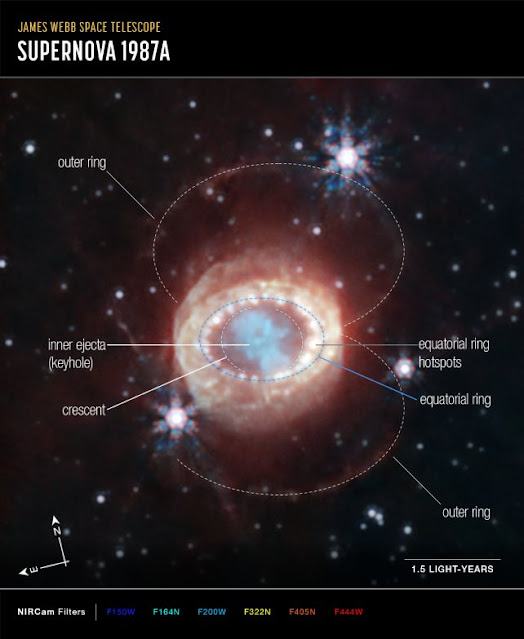James Webb Space Telescope Just Captured A Stunning Supernova Image That Reveals Structures We've Never Seen Before
We stand at the threshold of an astronomical revolution, as the James Webb Space Telescope (JWST) graces us with unparalleled observations in near-infrared wavelengths.
Among its most captivating discoveries is a deeper insight into SN 1987A, a core-collapse supernova first detected in February 1987, located in the Large Magellanic Cloud orbiting the Milky Way. The telescope has revealed startling structures within the supernova, inviting a reevaluation of our current understanding of stellar death and remnant formation.
Groundbreaking Observations: The Unique Anatomy of SN 1987A
While SN 1987A has been extensively studied across a spectrum of wavelengths, ranging from radio to gamma, JWST's recent foray into the near-infrared has revealed features never before seen in the remnants of a supernova.
The Keyhole-Shaped Dark Mass
At the heart of the supernova lies a keyhole-shaped dark blob. This is an agglomeration of cosmic dust so densely packed that it remains impervious even to JWST's advanced observational capacities. Preliminary evidence posits this opaque clump as a shield concealing a unique type of neutron star, known as a pulsar.
The Elusive Crescent-Like Structures
For the first time, JWST has identified peculiar crescent-like structures within the remnant's core. According to NASA, these crescents may represent outer layers of gas propelled outward during the supernova explosion. Their unique luminosity is believed to stem from "limb brightening," a complex optical phenomenon induced by our three-dimensional perspective on the expanding material.
JWST's Penetrative Capabilities: The Struggle Against Dense Dust
JWST employs near-infrared wavelengths which are less prone to scattering by cosmic dust, allowing for an enhanced view of underlying structures. Yet, even this state-of-the-art telescope could not penetrate the extremely dense central dust of SN 1987A to confirm the presence of the neutron star formed 168,000 years ago.
Ongoing Observations: The Future of Studying SN 1987A
The James Webb Space Telescope will continue to keep a vigilant eye on SN 1987A, mapping its evolution in granular detail. Through its incessant observations, we remain optimistic about locating the elusive neutron star and unraveling further secrets this extraordinary supernova holds.
A Milestone in Astrophysics
The recent observations of SN 1987A by the JWST signify a monumental step in our quest for comprehending the mechanics of stellar life cycles. As we delve deeper into the new data, it is clear that SN 1987A will remain an invaluable astronomical lab for years to come, potentially revolutionizing our understanding of supernova remnants and stellar evolution.
By capturing these unprecedented images and data, JWST has once again asserted its indispensability in modern astronomy, paving the way for a new age of cosmic exploration.
.jpeg)

Comments
Post a Comment